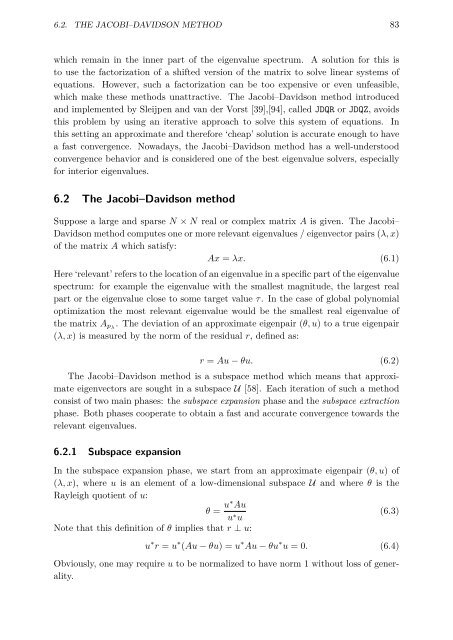link to my thesis
link to my thesis
link to my thesis
You also want an ePaper? Increase the reach of your titles
YUMPU automatically turns print PDFs into web optimized ePapers that Google loves.
6.2. THE JACOBI–DAVIDSON METHOD 83<br />
which remain in the inner part of the eigenvalue spectrum. A solution for this is<br />
<strong>to</strong> use the fac<strong>to</strong>rization of a shifted version of the matrix <strong>to</strong> solve linear systems of<br />
equations. However, such a fac<strong>to</strong>rization can be <strong>to</strong>o expensive or even unfeasible,<br />
which make these methods unattractive. The Jacobi–Davidson method introduced<br />
and implemented by Sleijpen and van der Vorst [39],[94], called JDQR or JDQZ, avoids<br />
this problem by using an iterative approach <strong>to</strong> solve this system of equations. In<br />
this setting an approximate and therefore ‘cheap’ solution is accurate enough <strong>to</strong> have<br />
a fast convergence. Nowadays, the Jacobi–Davidson method has a well-unders<strong>to</strong>od<br />
convergence behavior and is considered one of the best eigenvalue solvers, especially<br />
for interior eigenvalues.<br />
6.2 The Jacobi–Davidson method<br />
Suppose a large and sparse N × N real or complex matrix A is given. The Jacobi–<br />
Davidson method computes one or more relevant eigenvalues / eigenvec<strong>to</strong>r pairs (λ, x)<br />
of the matrix A which satisfy:<br />
Ax = λx. (6.1)<br />
Here ‘relevant’ refers <strong>to</strong> the location of an eigenvalue in a specific part of the eigenvalue<br />
spectrum: for example the eigenvalue with the smallest magnitude, the largest real<br />
part or the eigenvalue close <strong>to</strong> some target value τ. In the case of global polynomial<br />
optimization the most relevant eigenvalue would be the smallest real eigenvalue of<br />
the matrix A pλ . The deviation of an approximate eigenpair (θ, u) <strong>to</strong> a true eigenpair<br />
(λ, x) is measured by the norm of the residual r, defined as:<br />
r = Au − θu. (6.2)<br />
The Jacobi–Davidson method is a subspace method which means that approximate<br />
eigenvec<strong>to</strong>rs are sought in a subspace U [58]. Each iteration of such a method<br />
consist of two main phases: the subspace expansion phase and the subspace extraction<br />
phase. Both phases cooperate <strong>to</strong> obtain a fast and accurate convergence <strong>to</strong>wards the<br />
relevant eigenvalues.<br />
6.2.1 Subspace expansion<br />
In the subspace expansion phase, we start from an approximate eigenpair (θ, u) of<br />
(λ, x), where u is an element of a low-dimensional subspace U and where θ is the<br />
Rayleigh quotient of u:<br />
θ = u∗ Au<br />
u ∗ (6.3)<br />
u<br />
Note that this definition of θ implies that r ⊥ u:<br />
u ∗ r = u ∗ (Au − θu) =u ∗ Au − θu ∗ u =0. (6.4)<br />
Obviously, one may require u <strong>to</strong> be normalized <strong>to</strong> have norm 1 without loss of generality.

















